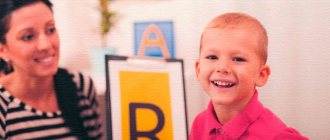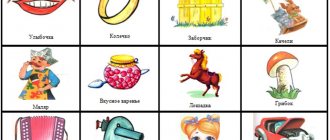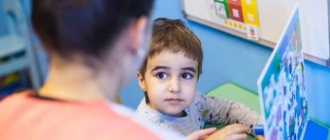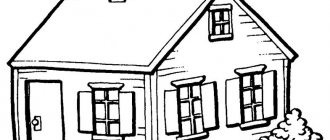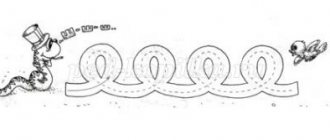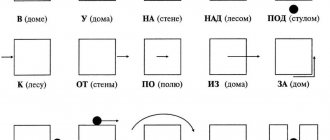Children have various problems with many letters in the process of speech formation. One of the most common difficulties is setting the sh sound. Typically, children find it difficult to pronounce hissing sounds for the reason that they cannot relax the tongue and position it in the required shape, which is required by the correct articulation of the sound sh.
Causes of impaired pronunciation of the sound Ш
If the child is healthy and does not have problems with hearing and intellectual development, then the following factors may be the reasons for the distortion of the pronunciation of the sound Ш:
- Defective speech breathing. The child speaks quietly, is often interrupted, and the end of sentences is chewed due to lack of air in the lungs. Sound pronunciation is distorted due to difficulty breathing when speaking. The problem can be identified by the fact that, while talking, the patient exhales air through the nose sharply, noisily, and also takes in short breaths halfway through the sentence. If you have this problem, you can practice at home. With daily exercises lasting about 5 minutes, positive results can be achieved within a month.
- Defective speech hearing. In this case, the patient does not distinguish words that sound similar. Moreover, he believes that he speaks correctly, the way the people around him speak. Due to impaired phonemic hearing, difficulties arise while studying at school. Reading and writing are difficult for schoolchildren, and dyslexia often develops. The development of phonemic hearing begins at the stage of intrauterine development, so pregnant women are recommended to talk with the fetus in the stomach. Hearing development is completed by the age of 4, and if a child by this age still distorts spoken sounds, then he should be taken to a pediatrician and speech therapist.
- Weakness of the articulatory apparatus. The clarity of sound pronunciation is determined by the level of functionality of the articulatory system and the quality of work of the oral organs. With a defective location and weakness of the organs of the oral cavity, the pronunciation of sounds is distorted. We are talking about an abnormal bite, abnormal structure of the palate, crooked teeth growth. All these are factors leading to dysarthria. To normalize pronunciation, the development of linguistic and facial muscles is required.
- Abnormal structure of the frenulum. Each person has an individual length of the frenulum - the webbed strip of tissue under the tongue. But a child may experience speech impediments if the frenulum is too short, causing the tongue to not reach the roof of the mouth or extend out of the mouth to a sufficient length. In young children, the problem manifests itself as a violation of the sucking function, in older children - the formation of an abnormal bite. Correction of the problem is first surgical (trimming in a dental clinic), then speech therapy. Typically, small patients whose frenulum is so short that the tongue can hardly lift up are sent for surgery. If the problem is not so serious, then speech therapy sessions to develop the hypoglossal ligament are sufficient.
Why doesn't the letter "Ш" hiss?
The reasons for incorrect pronunciation may be the following:
- Physiological: malocclusion, large tongue, high palate. In addition, the quality of the spoken sound depends on the development of the speech apparatus.
- Prolonged use of the pacifier. This item spoils the bite, which leads to distorted pronunciation of whistling and hissing sounds.
- "Lisping" with a child. By repeating after their elders, children distort their speech.
- Repeating incorrect pronunciation after adults who have speech impediments.
- Memory, thinking and attention are poorly developed.
- Speech hearing impairment (in some cases, dyslexia may develop).
If, after homework, the child still cannot pronounce the letter “SH,” you should contact a speech therapist.
Staging the sound Ш step by step
When pronouncing each sound, parts of the articulation apparatus take a certain position. If the organs of articulation are placed incorrectly at the time of pronunciation, then a distorted sound is obtained.
The articulation of the sound Ш is correct when the speech organs are located as follows:
- The lips are slightly pushed forward, folded in the shape of an open pipe.
- The tip of the tongue rises to the palate, but does not rest against it. There should be a gap left.
- The tongue is cupped and pressed against the inner sides of the upper teeth with its lateral edges.
- The vocal cords remain relaxed. The air stream comes out of the mouth freely.
Exercises are carried out both with a speech therapist and at home. But parents learning how to make the sound Ш for their child at home need to take into account that classes should be regular. This is the only way to achieve a quick positive result.
Possible deviations
During the examination, it can be revealed that the sound “Ш” is pronounced incorrectly. Despite the fact that this sound is considered dull, it must be pronounced clearly and cleanly.
Possible deviations:
- The child sticks his tongue out too much between his teeth, resulting in a lisping sound.
- Sigmatism in “Ш” appears when there is strong tension in the deep part of the tongue. Then “W” is replaced by “X”.
- With lateral sigmatism, a “pop” is produced.
- Dental parasigmatism - the tongue rests on the upper incisors. Instead of "W" you get "T".
- With labiodental parasigmatism, “W” sounds like “F”.
- Instead of "SH" sounds "S", this is whistling parasigmatism.
It is important to tell your child how the speech organs should be positioned correctly. Classes should be accompanied by visual analogies and demonstrations.
Articulatory gymnastics for producing the sound Ш
The first and mandatory stage of a speech therapy session is articulation gymnastics. It is necessary to restore tone to the muscles of the speech apparatus.
Articulation gymnastics for the sound Ш may include the following exercises:
- "Hippopotamus". The patient opens his mouth wide for 5 seconds, then closes it.
- "Little Frog." You need to smile widely, leaving your teeth closed.
- "Tube". The child stretches out his lips with a pipe and holds it for several seconds.
- "Yummy". You need to relax your tongue so that it takes a flat shape and lick your upper lip with it.
- "Pancake." A flat, relaxed tongue should be placed on the lower lip for a few seconds.
- "Drawing". The child moves the tip of his tongue, like a brush, across the palate from the teeth to the uvula.
Lesson 5
Automation of the sound [ш] in syllables with a combination of consonants Development of articulatory motor skills Work on the voice Game exercise “Conversation of monkeys.” Memorizing and reproducing syllables with the inclusion of facial exercises. - Shma-shmo. (sad) - Shma-isho-shmo (with grief) - Shma-shmo-shmo-shmo? (interrogatively) - Shna-shno. (offended) - Shna-shno-shnu. (approvingly) - Shna-shno-shnu-shna! (joyfully) Game exercise “Monkeys peel bananas.” Coordination of speech with hand movements - imitation of the movements of monkeys. Shva-shvo; seam-shwo-shvu; seam-seam-seam-seam. Development of phonemic awareness - Find pictures that have the sound [sh] in their names and put them next to the letter sh. Pictures are laid out in front of the child, the names of which contain the sounds [w] and [s]. The teacher names the words, and the child finds the desired picture. Determining the position of a sound in two or three words. Composing syllables from a split alphabet. Reading syllables
Mimic gymnastics
This is a special part of articulatory gymnastics for the sound Ш, toning the facial muscles, preparing them for work.
Mimic gymnastics consists of a set of exercises:
- Move your lips left and right. 5 times in one direction and the other. After a short pause, repeat 4 more times.
- Inflating now the right, now the left cheek. Repeats 5 times with short pauses.
- Wrinkling the eyebrows and puffing out the cheeks to create an angry expression. Repeat 4 – 5 times.
- Raising the eyebrows to create a surprised face. Repeat 4 – 5 times.
- Alternating frequent blinking and slow opening and closing of the eyes.
- Image of any funny faces.
To make it more interesting for your child to study, you can use rhymes and stories to accompany the exercises. This will have double benefits - the development of facial expressions and memory training.
Lesson 2
Automation of the sound [sh] in reverse syllables Development of articulatory motor skills Work on the voice Pronunciation of the syllables ish-ish-ish, ish-ish-ish, ash-ash-ash, osh-osh-osh, ush-ush-ush on behalf of the heroes of the fairy tale “ Masha and the Bear" (with a change in intonation). Memorization and reproduction of syllable series ish-ish-ash, ish-ish-ash, ish-ish-ash-ush, ish-ish-ash-ush Analysis and synthesis of syllables - Repeat the syllables sha-shi-sho. Listen again. Sha-shi. Which syllable disappeared from the series? (Sho.) Sho-shu-shi-sha. Sho-shu-shi? (Sha.) - Listen and repeat the syllables ish-ish-ish. What new syllable appeared? Ish-ish-ash. - Let's “make friends” two sounds - the vowel [a] and the consonant [w]. What syllable will be produced if the first sound is [a], and next to it is [w]. Indicate sounds with color symbols (red and blue circles). - What is the first sound in the syllable ish? What's the second sound? - Name the second sound in the syllable osh? Composing the syllables ish, ish, ash from letters of the split alphabet. Development of phonemic perception Game “Speech Lotto”. Selection of pictures whose names contain the sound [w] from a number of others. The teacher names the words, and the child finds pictures with the sound [w].
Breathing exercises
Performed after articulation gymnastics. The following game-based speech therapy exercises are recommended for establishing the sound Ш:
- "Football". The speech therapist places a cotton ball on a horizontal surface and invites the patient to score a goal into an improvised goal with a stream of air. But the cheeks cannot be inflated; the air is blown out only with the participation of the lips folded into a pipe. It is advisable for the speech therapist to hold the child’s cheeks with his palms during the exercise. The exhalation should be such that a solid, even air flow comes from the mouth.
- "Butterfly" on a flower. A butterfly and a flower are cut out of colored cardboard and connected. The speech therapist asks the patient to blow the butterfly off the flower in a manner similar to the above.
Lesson 4
Automation of the sound [ш] in syllables with a combination of consonants Development of articulatory motor skills Working on the voice Memorizing and reproducing a syllabic series in combination with movement. Game exercise “We are weightlifters.” Shta-shta, shta-shta; piece-piece-piece-piece (raise and put down the barbell). "Conversation between Cheburashka and Tumbler." - What, what, what. (angrily) - Shty-shty-shty? (Good-naturedly. Why are you so angry?) - Wow. (Affectionately. Let's be friends.) - What-what-what? (Interrogative. Do you agree?) - What-thing-thing-thing. (Affirmative. I agree.) Development of phonemic awareness - Find pictures whose names contain the sound [w], and put them next to the letter w. Pictures are laid out in front of the child, the names of which contain the sounds [w] and [z]. The teacher names the words, and the child finds the desired picture. Determining the position of a sound in two or three words. Reading the syllables ush, shu; oh, sho
Exercises for producing Ш from the sounds T, S, R and vowels
Methods such as placing the sound Ш are common in speech therapy practice and give quick positive results. They are carried out as follows:
- From sound C. This setting option is used when the patient has no defects in the functionality of the speech apparatus. The child raises his tongue to the sky, pronounces S in a relaxed manner. Then he releases air, continuing to pronounce. A hissing sound comes out. The air stream should flow without tension in the facial muscles or distortion of facial expressions. This exercise helps the child understand how whistling sounds differ from hissing sounds. Often, children have a problem with the sound Ш due to a mixture of the upper sibilant with the lower sibilant.
- From the sound T. This method of correction is used when a child is diagnosed with interdental sigmatism. At the first stage, the patient learns to touch the upper teeth with the tip of his tongue, pushing it out slightly. This is how the T sound is practiced. Next, the soft form of T is pronounced several times at a slow pace. When pronouncing, the exhaled air flow lengthens; the tip of the tongue does not need to reach the teeth. As a result, Sh is formed.
- From the sound R. This technique is practiced when the child has no problems with the pronunciation of R. The exercise is carried out in front of a mirror using the method of imitation: the patient follows the movements of the speech therapist and repeats them. The sound R is pronounced in a whisper, the air stream gradually weakens and stops vibrating. A hint of hissing appears. A few sessions are enough for the patient to start hissing without first saying R.
- From the vowels A, E, Y. If the production of the above consonants causes difficulties, then vowels can be used. In this case, classes are not carried out at home, as they require accurate and competent work with a speech therapy probe. The patient pronounces vowels, and the speech therapist at this time raises his tongue to the sky using a probe.
When to see a speech therapist
Distortion and replacement of sounds in three-year-old children is not considered a deviation. But if at 2 years old the child has no speech, then it is worth going to a consultation with a specialist. Only by the age of 5 does the formation of the phonetic series end. The setting of "Sh" occurs between the third and fifth years of life.
Violation of the pronunciation of “Ш” is correctable and is often eliminated relatively easily. The main thing is that classes are regular and systematic. It is important that the little student himself has the desire to correct his speech and pronounce “Sh” correctly.
The child and parents must show patience and perseverance during lessons. If the results are poor, then you should contact a speech therapist. A specialist can place “Ш” from the reference sound with mechanical assistance, using a probe or spatula.
Setting the sound Ш mechanically
One of the effective ways of producing the sound Ш is using a speech therapy probe. The action plan is as follows:
- The child pronounces the long sound C with a high tongue position. The lips should be stretched in a smile so that the upper and lower incisors are visible. There should be a small distance between the teeth.
- When pronouncing C, the speech therapist inserts a probe into the patient’s mouth and presses it on the tip of the tongue. He tries to push the tongue deeper so that a hissing shade is formed.
- The child squeezes the probe with his teeth, not stopping hissing.
- The specialist forms a tube from the child’s lips, squeezing the corners of the mouth with his fingers. The result is a clear sh sound.
Then the little patient can train independently in front of a mirror.
Gradually, training using a probe needs to become more complicated, moving from simple hissing to pronouncing hissing syllables and words.
Lesson 3
Automation of the sound [w] in syllables (intervocalic position) Development of articulatory motor skills “The little mice are whispering.” Pronouncing syllable combinations yshi-yshi-yshi, asha-asha-asha, usha-usha-usha, ishi-ishi-ishi, osho-osho-osho, ashu-ashu-ashu, oshi-ishi-ashi on behalf of the little mice (including facial exercises). Development of phonemic perception - Name the place of sound in the syllables sha, ash, asha. Where is the sound [w] heard in the words Shun (mouse's nickname), mouse, mouse?. Reading the syllables sha, sho, shi Development of auditory memory and attention Following instructions of 2-3 actions. - Go to the closet. Take the mouse. Place the mouse between the matryoshka doll and the horse, and then sit down.
Setting the sound Шь
It is also the sound Shch, dull and soft.
The articulation is as follows:
- the tongue rises to the upper jaw, its lateral edges are pressed against the inside of the teeth;
- tongue muscles are tense;
- when exhaling, the tip of the tongue presses on the palate;
- lips are stretched out like a tube;
- The gap between the upper and lower teeth is no more than 5 mm.
A stronger warm stream of air comes out of the mouth than when pronouncing Sh. The sound is more viscous and tense. The air does not vibrate.
The sound Шь is placed after the full formation of Ш. The patient is asked to pronounce the long sound Ш, stretching his lips in a smile and pointing his tongue forward until Shch is heard. Sometimes Shch is formed on its own, when all other hissing sounds have been set.
Imitation exercises and game methods give good results.
Lesson No. 6
Automation of the sound [ш] in syllables with a combination of consonants Development of articulatory motor skills Work on voice and facial expressions Game task “Conversation with aliens.” - Shko-shko-shku. (surprised) - Sla-shl-slu-shl. (with indignation) - Shpa-shpo-shpu-shpa. (with sadness) - Shl-shl-slut. (with apprehension) - Shmi-shni-shpi! (joyfully) Development of phonemic awareness - Match the pictures to the letters. For the letter w put pictures whose names contain the sound [w], for the letter w - pictures whose names have the sound [z], for the letter s - pictures whose names have the sound [s]. The teacher names the pictures, and the child selects the desired picture and places it next to the corresponding letter. Composing and reading syllables Tasks used at the stages of automation of the sound [sh] in words, phrases, sentences and connected speech Automation of the sound [sh] in words with the syllables sha, sho, shu, shi, she Pronounce the words correctly Ball, balls, hat, puck, niche, noodles, checkers, naughty, yours, ours, porridge, roof, donkey, hanger, little mice, horse, chess, champignons. Driver, rustle, bag, fluff, pot, cockerel, strap, comb, mouse. Noise, jester, fur coat, joke, teddy bear, screw, scale. Ears, tire, thorns, awl, sewing, mice, screen, lilies of the valley, reeds, babies, galoshes, car, cotton grass, silence, ladle, jug, water lily, driver, pea, rose hip. Neck, pole, target, millet, couch, collar, rustle, hornet, pebble, mousetrap, mulberry. Tasks Name the objects. Pronounce the words clearly. Determine the place of the sound in each word. Divide the words ball, hat, hanger, champignons into syllables. Guess the word I have in mind. In this word, the first syllable is ve, the last is ka. Collect words from scattered syllables. The word has the following syllables: sha, we, ta. Figure 10. (See color insert.) Children: Misha, Masha, Dasha, Lusha, Ksyusha, Lesha, Pasha, Sasha, Alyosha, Andryusha. What are the girls' names? Natasha is taller than Masha. Katyusha in a hat. Ksyusha in a hat. Who is taller - Misha or Pasha? Who is older - Lesha or Andryusha? Who is smaller - Dasha or Sasha? Who has the puck? Who has the balls? Who's wearing a hat? Who has a scarf on his neck? Who has the car? Who's standing? Who's walking? Drawing Sewing machine, passenger car, washing machine. Name the objects in one word. How do you turn the word car into the word tire? Repeat the words step, steps, step, step. These words are called cognates. Fill in the missing letter and pronounce the words clearly. ...ar...arf...aiba...ariki Tell me the right word. The jumper jumps with... (pole). The train is driven by... (driver). The hole can be pierced... (with an awl). We admire... (water lily, lilies of the valley). Pour the milk into ... (jug). Pour water... (with a ladle). The driver drives... (the car). Which syllable is missing? Ti...na (silence), ma...na (car). Name words with the syllables sha, shi, shu. Why were bushes and trees called that - rosehip, mulberry? The wild rose has prickly thorns. Silkworm caterpillars (silkworms) are grown on mulberry trees. Silkworm caterpillars feed on mulberry leaves. They spin cocoons from silk threads, in which they transform into pupae. Cocoons unravel and weave silk fabrics. Automation of the sound [w] in words with the syllables ash, ush, osh, ish, ish, esh Pronounce the words correctly Tower, turret, cup, shirt, daisy, bug, pencil. Shower, mascara, cannon, edge, cuckoo, toy, reel, feeder, shell, frog, pillow, tub, grandfather, grandmother, fluff, jerboa. Finish, little house. Midge, cat, crumb, windows, peas, basket, palm, potato, okroshka. Mouse, mouse, baby, reed, donut, tower, lid, baby, monkey, tire. Nuts, sturdy, rattle. Tasks Say it kindly. Cherry is a cherry, a cat is a cat, a mouse is a mouse. Which letter is lost in these words? Kotka, skein, wash, cone. Why was the first dish called okroshka? Rebus. A teapot, a bus, a fur coat, a bush, an orange. Name the objects. Highlight the first sound in the names of objects. Make up a word from these sounds. (Cup.) Automation of the sound [w] in words with a combination of consonants Pronounce the words correctly Headquarters, barbell, pants, stack, stamp, darning, curtain, corkscrew, steering wheel, thing, bayonet. Wardrobe, box. Hat, helmet, boat. School, student. Sleepers, twine. Tasks Replace the sound [p'] with the sound [t'] in the word spire. What word did you get? (Calm.) Syllable chain. Mouse - reel - reel. Say it kindly. Hat - hat, fur coat - fur coat, pants - pants, shirt - shirt, cone - cone, hat - cap, mouse - mouse, ball - ball, reel - reel. Choose rhymes. Pictures and words. Two columns of drawings. Mouse - quiet, cat - midge, baby - cat - cloudberry, ka-dushka - coil - pillow - girlfriend, hut - tub, toy - cuckoo, pillow - frog, bear - mouse, cone - Quiet, guns - ears, dryers - flies, old woman - cheesecake, window - basket, okroshka - potatoes, cockerel - scallop. "Is it correct?" The guns are firing, the cannons are baking. A cat grows in a swamp, a cloudberry sits under the table. There are toys on the tree, and cuckoos in the hands of the children. "Useless and useful advice from the old woman Shapoklyak." Salt frogs in tubs. Place the cuckoo on your pillow to sleep. Throw the coils at the windows of the hut. Place the midge in the basket. Don't litter in the hut. Salt the volushki in a tub. Treat the old lady to cheesecake. Don't kill frogs! Take care of the cuckoos! Repeat the helpful tips first. Why can other advice be called useless? What's extra? Make up the letters for the girl's name and the name of her clothes. A, K, A, P, M, Sh, B, L, U, R, F. - Which letter is lost? ...stranded, Roma...ka, carto...ka. - How are these words different? Moshka is a cat. A hat is a boat. The fur coat is a joke. Sleeper - noodles. How are they similar? "What's going where?" Flutters in ... (tub), feathers in ... (pillow). “What to whom?” For the baby - a rattle, for the kids - toys, for the old lady - cheesecakes, for Mashenka - cherries, for Mishenka - pants, a shirt, for the frog - a midge, for Cheburashka - a chamomile, for the cockerel - grains. Automation of the sound [ш] in phrases Complete the word. Woolen..., woolen..., woolen..., woolen..., fluffy..., fluffy..., fluffy..., fluffy..., big..., fragrant..., wide..., good.... Choose the right words. What are you doing? Tell me about yourself. I... (walk, breathe, wave); listening music); spoon soup ... (stir); problems... (solve); with a needle... (sew). Tell me about Misha. Misha, with your eyes... (look, blink, look); ears... (listening); with your feet... (you walk, you walk, you run, you walk); with your hands... (catch, throw, wave, do); door... (open, close); ball... (catch); with a doll (playing); pencil... (draw); by car... (you drive); on the plane... (flying). Imagine that mom sent Masha to the store. We will guess what she is doing and tell her about it. You go to the store... (enter), groceries... (choose), money... (pay), groceries in the bag... (put), home... (bring), out of the bag... (put out), in the refrigerator... (put). Tell me about yourself. I will ... (write a letter), and sew up a hole in the dress ... (sew up). Automation of the sound [w] in sentences and in coherent speech Sentences of two words The kids are making noise. The mouse rustles. Natasha writes. Misha is a naughty guy. Ksyusha is big. Three word sentences The cat catches up with the mouse. Katyusha buys chess. The cockerel pecks the cherries. Mashenka eats chocolate. Pasha is fixing a hanger. The cat knocked over the jug. Natasha found a pebble. Mashenka was given a scarf. Make three-word sentences with the following words: cone, cuckoo, Misha, car, top. If you were an artist, what could you draw with the sound [w]? Sentences of four or five words or more Aunt Dasha is sewing a shirt. Grandma is darning Misha's panties. Uncle Pasha is plowing the arable land. Masha puts Mishka on a shirt and pants. The car has rubber tires. A bug sits on a large daisy. Volnushki are salted in a tub. Frogs croak at the forest edge. A cone fell on the mouse. Peas were scattered on the path. The bear is sitting in the car. The mouse fell into the mousetrap. The frog jumped onto the water lily. Natasha plays with a teddy bear. Grandfather plays checkers with Misha. Grandfather is lying on the couch. Masha hangs her fur coat in the closet. Lusha washed her neck and ears in the shower. Grandmother and Alyonushka sat down on a log. Sentences with conjunctions a, and Dasha and Pasha play chess. Alyonushka has a basket, and Mashenka has a mug. Pasha built a turret, and Misha built a house with a roof. The porridge is eaten with a spoon, and the compote is drunk from a cup. Dashenka plays with a matryoshka doll, and Misha plays with a toy car. Alyonushka took the bowl and fed the cat. Yasha went out to the edge of the forest and saw a cuckoo there. Tasks Distribution of proposals. What is Dasha doing? Dasha is sewing. What does Dasha sew? Dasha is sewing pants. What does Dasha sew on? Dasha sews pants on a sewing machine. Who does Dasha sew pants for? Dasha sews pants for a bear on a sewing machine. Complete the sentences with. The bunny has long... (ears). Here sits a green frog... (abdomen). The kids are walking to... (school). The pie is good, inside... (curd). Mushrooms in a tub, grandfather in ... (hut). Name the extra word in the sentence. The rose hips have prickly thorns and bumblebees. A frog sits on a water lily, a tub. The cat rolls a reel, a rattle. Who can I contact like this? Please do for me... I ask you, please help... Contact me with a request. Unprecedented. Figure 14. (See color insert.) Cuckoo in a hood. The cat drives the car. Frog in the air in a hot air balloon. Mouse in a hat. Horse in boots. The bear dances with the mouse. The mouse catches the cat. Come up with fable sentences. "Learning to think." Development of cognitive processes. Find the differences. Drawing of Confused Masha and a girl dressed correctly. Clothes on girls. Scarf, hat, shoe laces, fur coat, mittens. What can’t Masha go for a walk without in winter? To the beach? What will Masha wear to kindergarten? Figure 16. (See color insert.) Cats of different colors, a mouse, a wardrobe. The cat is on the closet, under the closet, behind the closet. Where does the tabby cat sit? Where is the red cat? Where is the mouse peeking from? Topics for composing stories and fairy tales “Birds”. Why are they called that? Avocet, pintail, shoveler, broadtail, broadmouth, mockingbird, stonewall. turnstone, warbler, moorhen. Which bird sits higher than the others? Which bird is on the left and which is on the right? "Visiting Cheburashka." Key words: Cheburashka, Mishutka, monkey, Tumbler, Matryoshka, Parsley, lily of the valley, chamomile. "The Adventures of Sharik and Pushka." Key words: cart, hut, grandfather, grandmother, cheesecake, Alyonushka, hut, river, shell. “Mishutka Toropyzhka is looking for friends.” Key words: mouse, cone, frog, bumblebee, obedient hedgehog, naughty hedgehog. “How the bear Toptyzhka visited the kindergarten.” Key words: Natasha, Masha, tumbler, matryoshka, machine, ball, naughty, noise, closet, books. "Teremok". Write your own fairy tale about the little mansion. Use the words frog-frog, mouse-norushka, cockerel - golden comb, bunny-coward.
Automation of the sound Ш in game exercises
Sound automation classes are conducted in stages:
- the sound is placed in isolation;
- fixed in syllables;
- pronounced in words and phrases;
- enshrined in poems, tongue twisters, and tongue twisters.
Preschoolers and primary schoolchildren show greater interest in activities conducted in a playful way. It is desirable that games be accompanied by rich illustrative and textual material.
The automation scheme for the sound Ш in syllables is as follows:
- first, syllables are pronounced where the initial sound is Ш (“sho”, “sha”, “she”);
- syllables with initial vowels are developed (“ash”, “esh”, “ush”);
- syllables with several consonants (“curtain”, “jester”, “seamstress”) are fixed.
Automation of the sound Ш in words is carried out as follows:
- words with Ш at the beginning, end and middle are pronounced;
- The lessons end with phrases and sentences with Ш, first simple, then complex.
There are many options for automation games. Below are the most popular ones:
- “Help the snake get home.” A labyrinth is drawn. A snake is depicted at one end, and a hole at the other. The child should be asked to run his finger through the maze from the snake to the hole, while making a hissing sound.
- “Help the mouse escape from the cat.” The speech therapist invites the child to read syllables and words with Ш, while gradually increasing the speed of reading and trying not to get lost. As reading speeds up, the mouse runs away from the cat faster and faster.
- A speech therapist can compose a speech therapy story or fairy tale on his own or find it on the Internet, where the sound Ш is repeated many times. The child must read the proposed text without making mistakes in pronunciation.
Strengthening pronunciation
Exercises to automate the sound “Ш”
Exercise on adding endings with the sound “Ш”:
| SHA | SHI | SHU |
| Doll Yes... (sha). | Masha cleans the... (shi). | In the library you have to be quiet... (SHE). |
| Girl Nata... (sha). | We squeak... (shi). | Mom gave candy to Ma...(SHE). |
| Son of Ale... (sha). | Landas are collected in the forest... (shi). | |
| Parrot Kiryu... (sha). | Little ones don’t go to school... (shi). |
Replace the first sound with Ш: slippers - hats, lips - fur coats, soap - awl, steam - ball.
Form a diminutive word: winter - winter, aunt - aunt, mistress - hostess, bread - bread, spot - speck.
Exercises to improve speech hearing:
- Guess the animal. You need a tape recorder with recordings of the sounds of various animals. The child needs to differentiate and name the animal.
- Finger game "Weather phenomena" . The one who conducts the game must name one of the phenomena; the child must knock on the table. For example, when pretending to thunder, a child needs to knock on the table with his fists. Depict lightning with light strikes of the fingers, while pronouncing a long sound Sh.
Promoting speech development in children
In order for the child’s speech to develop correctly, in accordance with age, parents, in consultation with a speech therapist, must carry out the following work:
- create a favorable communication environment, speak clearly and competently, do not distort words;
- Explain to your child all your actions (this is important for quickly mastering concepts);
- gradually generalize concepts, form semantic connections;
- show manipulations with various objects, ask them to repeat and pronounce their actions;
- play with the child, read with him.
The production of the sound Ш is carried out in stages; it is necessary for the formation of beautiful and clear speech. Classes are held not only with a speech therapist, but also at home. To quickly achieve a positive result, it is recommended to work with the child 2 – 3 times a day.
Causes
The main reason that a child cannot speak hissing sounds correctly is the way the parents communicate with the baby. Many adults deliberately copy the speech of a child, speaking to him in a childish way. Thus, the child hears the incorrect pronunciation and gets used to precisely this manner of producing the sound sh. That is why experts strongly recommend that parents speak to their children correctly.
In addition to the parental desire to imitate baby babble, some structural features of the articulatory apparatus play an important role in the production of the sound sh, which include the following points:
- tongue movement is limited due to the shortened hyoid ligament;
- articulation is affected by the size of the lips (too thin or full) and the size of the tongue (too large or small);
- dental anomalies;
- disruption of the auditory canal.
In most cases, a violation of the production of the sound w can be quite easily corrected at home with regular and careful work with the child. In some cases, children who have problems pronouncing hissing words will be helped by a speech therapist.
